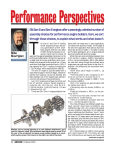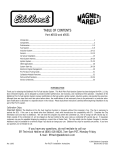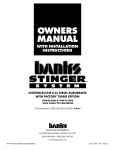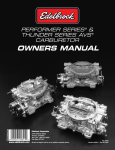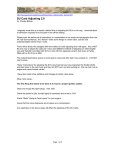Download Edelbrock 1902 Automobile Parts User Manual
Transcript
PERFORMER REPLACEMENT SERIES CARBURETORS FOR Q-JET APPLICATIONS for non-computer controlled Chevrolet/GMC V8s; 1966-89 CATALOG #1901, #1902, #1903, #1904 & #1906 INSTALLATION INSTRUCTIONS PLEASE study these instructions carefully before installing your new Carburetor. If you have any questions or problems, do not hesitate to contact our Technical Hotline at: 1-800-416-8628, 7 am - 5 pm, Monday-Friday, Pacific Standard Time or e-mail us at edelbrock.edelbrock.com. IMPORTANT INFORMATION ABOUT YOUR WARRANTY If you have any problems with installation or performance, do not return to the retailer. The retailer is not authorized to perform Warranty Service. Instead, call the Edelbrock Carb Tech Hotline at 800-416-8628 from 7am - 5pm PST on weekdays. All returns must be accompanied by the original purchase receipt. The warranty period is 90 days for new carburetors and 30 days for "as-new" (remanufactured) carburetors. DESCRIPTION The Edelbrock Performer Replacement Series Carburetor for Q-Jet applications is a high quality, all new carburetor designed to replace the original equipment Q-Jet spread-bore carburetors found on most 1966 -1989 non-computer controlled Chevrolet/GMC V8s. These carburetors are street legal/stock replacement parts when used on the applications for which they are listed. Edelbrock replacement carbs for Q-Jet applications are compatible with all OEM linkage and components for the years listed, and will fit stock intake manifolds. For best performance, they may be used with the matching Performer or Performer EGR intake manifold for those who wish to use a new stock replacement carburetor. 1. Five models are available for the following applications: #1901 (750 cfm) - Recommended for most small-block and bigblock Chevrolet/GMC V8s, 327 through 454 c.i.d., in both truck and BEFORE YOU BEGIN, ALWAYS REMEMBER TO: ❑ Replace fuel filter. Dirt found in carburetor voids warranty. ❑ Check and replace the air filter if necessary. ❑ Check PCV valve and replace if clogged. ❑ Check all hoses for leaks or cracks and replace if necessary. ❑ Check fuel pump for proper operation and replace if necessary. ❑ Check the intake manifold and cylinder head gaskets for leaks and replace if necessary. ❑ Check the ignition system: clean and gap or replace spark plugs, plug wires, and adjust ignition timing. CARBURETOR REMOVAL 1. Prior to removal make sure that the engine is cool. 2. Disconnect negative battery cable from battery. 3. Remove air cleaner. Be sure to carefully disconnect any hoses from the air cleaner and note their location for re-installation. You may want to mark them with masking tape for easy reference. 4. Disconnect throttle linkage, kickdown linkage (certain automatic transmission applications only), cruise control (if equipped) and any return springs if present. NOTE: Check carefully for the precise location of all these linkages and return springs. You may want to mark them with masking tape for easy reference. Compare throttle arm of your new carburetor with the old one to be sure that all required linkages will hook up. Ball stud is usually removable and must be installed in the proper location (see Figures 1 & 2). 5. Disconnect all wires, tubes and hoses from carburetor and note their location. NOTE: There should be a maximum of one wire to the electric choke and one to the idle compensator solenoid. Any other electrical wiring attached to your carburetor indicates a computer © 2002 Edelbrock Corporation Brochure No. 63-0073 passenger car applications using a remote style choke; 1966 to 1973. 2. 3. 4. 5. #1902 (750 cfm) - Recommended for most small-block and bigblock Chevrolet/GMC V8s, 350 through 454 c.i.d., in both truck and passenger car applications using a remote style choke; 1974 to 1978. #1903 (795 cfm) - Recommended for most small-block Chevrolet/GMC V8s, 305 through 454 c.i.d., in both truck and passenger car applications using a hot air style choke; 1975 to 1985. (Electric choke conversion, see choke linkage section.) #1904 (795 cfm) - Recommended for most small-block Chevrolet/GMC V8s, 305 through 350 c.i.d., in truck applications only using a full electric choke; 1980 to 1989. #1906 (795 cfm) - Recommended for big-block Chevrolet/GMC V8s-454 engines in truck applications only using a full electric choke; 1980 to 1989. controlled engine, and Edelbrock Q-Jet carburetors will not function correctly on computer controlled applications. Disconnect the heater tube from the choke housing (#1903 only). If the tube is burned out, replace it. Failure to do so will cause deposits to form inside the carburetor, improper choke operation, and void the warranty. 6. Carefully remove fuel line from carburetor or fuel filter. TAKE EXTREME CARE NOT TO SPILL ANY EXCESS FUEL. Place a rag Figure 1 underneath the fuel line to Throttle arm of #1901 absorb any spillage that may occur . Certain models require two wrenches to remove the fuel line; one to hold the fitting on the carburetor and the second to turn the fitting on the fuel line. Use a tubing wrench to avoid rounding the tube fitting nut. Figure 2 Page 1 of 4 Throttle arm of #1902,#1903,#1904 ݲ Rev 02/02 7. Remove mounting nuts or bolts and or washers. Be sure to put them where they won't fall into the intake manifold upon carburetor removal. 8. Remove carburetor, being careful not to spill any dirt into the intake manifold. Immediately place a clean rag into the manifold to keep foreign objects out. 9. Thoroughly remove old mounting gasket and clean mounting surface. Inspect gasket and match to gasket included with new carburetor. CARBURETOR PREPARATION 1. Place old and new carburetors side by side and transfer any accessories that are needed onto the new carburetor. CARBURETOR INSTALLATION 1. Remove rag from intake manifold and install new mounting gasket. NOTE: Do not use any cement, glue or liquid gasket. 2. Carefully place new carburetor on gasket. 3. Replace all mounting bolts, nuts and washers. Hand tighten with a short box end wrench, using even increments alternating between diagonally opposed bolts. Use stock mounting bolts or Edelbrock Q-Jet Bolt Kit #1925. CAUTION: Overtightening may break carb base. 4. For models with externally mounted fuel filters, install new fuel filter, starting threads by hand to avoid crossing or stripping threads. Replace any old or cracked hoses with new hoses designed for use with fuel. 5. Hook up fuel line to fuel filter. Start threads by hand. NOTE: Be sure threads are properly aligned before tightening to avoid crossing or stripping threads. When tightening fuel line use two wrenches; one to hold the fitting on the carburetor and the second to turn the fuel line fitting. Use a tubing wrench to avoid rounding the tube fitting nut. 6. Re-connect throttle linkage, wires, hoses, etc. Your Edelbrock carburetor may have more vacuum outlets than the original. Leave the caps on those outlets which won't be used. NOTE: #1901 and #1902 will accept the stock idle speed compensator bracket, GM #7042682. 7. Re-connect the air cleaner being careful not to over-tighten the mounting nut which could damage the carburetor. Install a new air filter (if needed) and re-connect all hoses. IMPORTANT NOTE: With engine off, make sure that there is no interference when opening and closing the throttle. Be sure that there is no binding or hanging up between idle and wide open throttle as this could cause the throttle to stick, resulting in loss of engine speed control. 8. Re-connect the negative battery cable to the battery. B C A I D E F G E H Front View of #1901 and #1902 J K B C L H M D E E G F I Front View of #1903, #1904 and #1906 LEGEND A - Diverter Port B - Choke Pull-down C - Fuel Inlet D - Exhaust Gas Recirculation (EGR) Port E - Idle Mixture Screws F - Positive Crankcase Ventilation (PCV) Port G - Canister Purge H - Distributor Port I - Idle Speed Screw J - Accessory Port K - Bowl Vent L - Hot Air (#1903 only) M - Fast Idle Screw N - Clean Air (#1903 only) O - 1/4" N.P.T. (Power Brake Port) © 2002 Edelbrock Corporation Brochure No. 63-0073 N O A Typical Rear View Page 2 of 4 Rev 02/02 CARBURETOR TESTING 1. Be wary of fuel leaks! If a fuel leak occurs, stop immediately and repair the leak. Failure to do so could result in engine fire and serious injury. NOTE: The following adjustments can affect vehicle emissions. Laws in your area may govern these emissions. 2. Set idle adjustments per factory recommendations for your vehicle. 3. The choke system is pre-set at the factory. However, minor adjustments may be required. Adjust using factory specifications for your vehicle. IDLE MIXTURE ADJUSTMENT parts, and Edelbrock makes choke linkage kits for use with Performer manifolds. Use Choke Kit #1931 for small-block Chevy Performers with divorced choke carbs #1901 & #1902; use Choke Kit #1935 for big-block Chevy Performers with divorced choke carbs #1901 & #1902. Figure 4 shows typical hot air choke connections as used on carburetor #1903. Stock manifolds can use original equipment choke parts, and Edelbrock makes choke linkage kits for use with Performer manifolds. Use Choke Kit #1930 for small-block Chevy Performers with hot air choke carb #1903; use Choke Kit #1934 for big-block Chevy Performers with hot air choke carb #1903. Some OE Q-Jet carbs with hot air chokes use a screw on nut located at the rear of the choke housing. For these applications, we recommend the use of the Edelbrock #1932. Some models use auxiliary vacuum diaphragm on the passenger side rear of carb, remove the diaphragm and install on the Edelbrock carb. Electric choke carburetor #1904 and #1906 require a 12-volt lead that is hot only when the ignition is on. The Edelbrock Performer Replacement Series Carburetor for Q-Jet applications has conventional Idle Mixture Screws (IMS) that provide a leaner Air/Fuel (A/F) ratio when turned clockwise and richer A/F ratio when turned counterclockwise. The idle air flow is controlled by a conventional screw that opens the primary throttles. The following procedure should be used to set the idle mixture and speed. 1. Fully warm engine and ensure choke is fully open. 2. Install air cleaner. 3. Set desired speed with the air screw. 4. Adjust the IMS on one side to get the maximum possible rpm or highest vacuum if you are using a manifold vacuum gauge. Do not go rich beyond the maximum speed point. 5. If the procedure above changed the idle speed more than 40 rpm, then readjust the idle speed. 6. Adjust the opposite side of that in Step 4 to get maximum rpm or vacuum. 7. Reset the speed. 8. Carefully trim each IMS to again get the maximum idle rpm or manifold vacuum. Figure 4- Hot air choke Figure 3- Divorced choke 9. Go leaner just enough to get a 20 rpm drop in speed. (#1903) (#1901 and #1902) 10. Reset the speed to the desired rpm. 11. This is a Lean-Best Idle Set. Setting richer than this will not improve idle Edelbrock Q-Jet Rebuild Kits The Edelbrock Performer Replacement Series Carburetors for Q-Jet quality or performance, but could cause higher hydrocarbon emissions and applications can be rebuilt with the following rebuild kits: tend to foul spark plugs. 12. Emission legal carburetors #1903, #1904 and #1906 are supplied with Rebuild Kit # Carb #s tamper resistant protective metal caps for idle mixture screw wells. These 1901 & #1902 #1920 covers should be installed following completion of final idle mixture 1903, #1904 & #1906 #1921 adjustments. NOTE: Use idle mixture adjustment tool K&D #2776 or equivalent. Replacement Fuel Filters The Edelbrock Performer Replacement Series Carburetors for Q-Jet WINTER FUEL IDLE SETS applications has a replaceable fuel filter element behind the Fuel Inlet Nut. During the winter months (in most parts of the country) the local fuel will be Replacement filters are available as follows: a "winter" blend that is very volatile, as an assist to cold-engine starting and driveability during warm-up. However, the high volatility has the Carb #s Fuel Filter # disadvantage of allowing excessive vaporization of the fuel if the vehicle is 1901 & #1902 #1970 operated in a heated area such as a garage. This can result in problems in 1903, #1904 & #1906 #1971 the idle-set procedures since the carburetor's internal vents will allow this excess vapor to be drawn into the throats and enrichen the mixture. The idle Q-JET CARBS WITH EGR VACUUM PORTS will be erratic and not seem to be able to hold a set. To resolve this The original carb on some Chevy/GMC trucks and Suburbans has the EGR problem, it is advisable to perform the final settings outdoors after the vacuum port machined higher in the carb venturi than the Edelbrock Qvehicle has been stabilized with a drive of several miles. Jet. This may have an effect on off-idle performance resulting in a flat FAST IDLE SOLENOID BRACKETS: spot. If you get a flat spot off-idle after installing the Edelbrock Q-Jet Your original Fast Idle Solenoid Bracket should mount to the Edelbrock Qcarb, you may need to install a vacuum delay valve. A simple test will let Jet Series carburetor. If a replacement bracket is desired, use GM you know if the delay valve is needed: a) Temporarily remove and plug the #7042682 for #1901 and #1902. Edelbrock #1997 is an adapter to connect vacuum line to the EGR valve. If the flat spot disappears, you will need to a factory vacuum operated throttle kicker to carburetor #1903, #1904 and purchase a vacuum delay valve (GM #14020691) and install it in the #1906. vacuum line between the carb and the EGR valve. This valve will delay the CHOKE LINKAGE INSTALLATION opening of the EGR valve long enough for the carburetor to transition The Edelbrock Performer Replacement Series Carburetors for through the off-idle phase without a stumble, then the EGR circuit will Q-Jet applications have three different types of chokes; divorced (remote), operate normally. hot air, and electric. Figure 3 shows typical divorced choke linkage used on #1901 and #1902. The metal housing which snaps in place over the Note: The vacuum line to the EGR valve should only be removed choke coil on manifold has been left off to show choke rod/coil relationship. temporarily as a test to determine whether the delay valve is The metal housing should be installed on your engine, as it retains the needed. You must re-install the vacuum line to the EGR valve in choke rod in the coil. Stock manifolds can use original equipment choke compliance with local and/or federal law! © 2002 Edelbrock Corporation Brochure No. 63-0073 Page 3 of 4 Rev 02/02 © 2002 Edelbrock Corporation Brochure No. 63-0073 Edelbrock Corporation 2700 California St. Torrance, CA 90503 Tech Line: 1-800-416-8628 E-Mail: [email protected] Page 4 of 4 THE FOLLOWING TROUBLESHOOTING CHART COVERS ONLY THE MOST COMMON PROBLEMS Rev 02/02 IMPROPER VACUUM: If rough idle cannot be cured by any of the vacuum leak checks, connect a vacuum gauge to a suitable source of full manifold vacuum. If the gauge needle fluctuates, it indicated internal engine problems. ROUGH IDLE: Rough idle is often caused by an air leak in the vacuum lines, or by dirt in the air bleeds. Disconnect the vacuum lines one at a time and plug the hose end and the fitting at the carburetor. If the idle roughness disappears, it indicates a leak. HESITATION: It is not unusual for hesitation upon acceleration to be caused by the carburetor's storage time. Allow a few hours of operation for the internal gaskets to become wet, and the problem will usually cure itself. FLOODING: Carburetor flooding immediately after installation is usually due to dirt or foreign matter lodged under the float needle. Gently tap on the air horn over the fuel inlet area with the head of a screwdriver. If flooding does not stop, pinch the fuel line (if possible), start engine and run until it stalls. Then release the pinched line. If flooding still persists, drain the fuel and restart. HARD STARTING: When starting the engine for the first time, it maybe difficult to start until fuel reaches the carburetor. TROUBLESHOOTING INSTRUCTIONS




